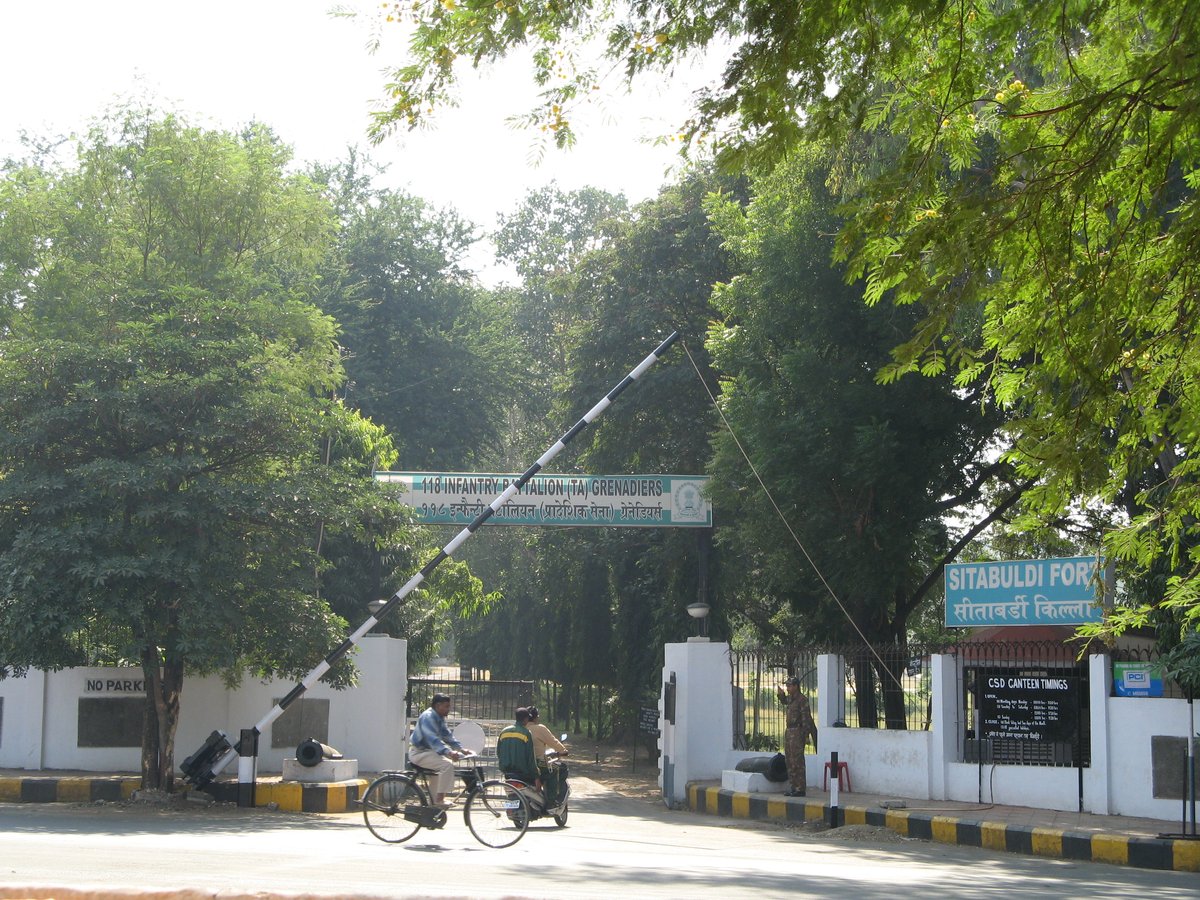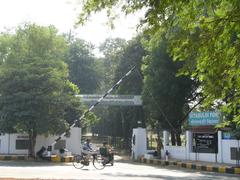
Sitabuldi Fort Visiting Hours, Tickets, and Guide to Nagpur’s Historical Landmark
Date: 15/06/2025
Introduction
Rising prominently atop the twin hillocks of Badi Tekri and Choti Tekri in the vibrant center of Nagpur, Maharashtra, Sitabuldi Fort is a living testament to the city’s layered history and strategic significance. Renowned for its unique blend of Gond, Maratha, and British military architecture, the fort’s panoramic vistas and rich heritage draw history enthusiasts, architecture lovers, and culture seekers alike. Although Sitabuldi Fort currently serves as an active military base with restricted access, it opens to the public on select national holidays, offering rare opportunities to delve into its storied past. This comprehensive guide details Sitabuldi Fort’s history, visiting hours, ticketing policies, accessibility, nearby attractions, and practical tips—ensuring a rewarding and informed visit to one of Nagpur’s most important historical sites. For the latest information, always consult official resources such as the Nagpur Tourism Website and curated guides like TripXL.
Contents
- Historical Overview
- Origins and Etymology
- Maratha and British Periods
- Battle of Sitabuldi (1817)
- Post-Colonial Era
- Fort Architecture and Key Features
- Strategic Location and Layout
- Walls, Bastions, and Gates
- Internal Structures and Memorials
- Visiting Hours and Ticket Information
- Accessibility and Travel Tips
- Nearby Attractions
- Preservation and Visitor Experience
- Frequently Asked Questions (FAQ)
- Summary and Recommendations
- Sources
Historical Overview
Origins and Etymology
The name “Sitabuldi” is thought to derive from “Shitlabadri,” referencing local rulers Shitlaprasad and Badriprasad Gawali in the 17th century. The site’s importance began under Gond king Raja Bhakta Buland Shah, who established a fortification in 1702. Its prominence grew during the Maratha era as the Bhonsle dynasty made Nagpur a regional power center.
Maratha and British Periods
During the 18th and early 19th centuries, Nagpur was a principal city of the Maratha Empire. The Treaty of Deogaon (1803) brought Nagpur under British influence, setting the stage for escalating tensions between Maratha rulers and the East India Company.
Battle of Sitabuldi (1817)
The pivotal Battle of Sitabuldi during the Third Anglo-Maratha War (November 1817) was fought on the fort’s twin hills. Despite being outnumbered, British forces repelled the Maratha army led by Appa Sahib Bhonsle. The British victory led to Nagpur’s annexation and the construction of a new, fortified structure on the site (TripXL).
Post-Colonial Era
After India’s independence, the fort remained an Indian Army base, notably housing the 118th Infantry Battalion (Territorial Army) Grenadiers until 2019. It now serves as a war memorial and symbol of Nagpur’s resilience and evolving identity (apnanagpur.com).
Fort Architecture and Key Features
Strategic Location and Layout
Situated on Badi Tekri and Choti Tekri, Sitabuldi Fort’s elevated site commands sweeping views over Nagpur and the surrounding region—a deliberate defensive choice. The fort’s layout follows the twin hills’ contours, with the main fortification on Badi Tekri and subsidiary defenses on Choti Tekri. This dual-hill design maximized surveillance and artillery advantage (Citybit.in).
Walls, Bastions, and Gates
The fort’s thick stone walls and bastions, constructed from basalt and sandstone, reflect a mix of indigenous and colonial engineering. Bastions project outward for defensive coverage, while the main gate is fortified with iron-spiked wooden doors. Ramparts with parapets and loopholes allowed defenders to repel attackers while minimizing exposure (Citybit.in).
Internal Structures and Memorials
Key features include:
- Barracks and Administrative Buildings: Utilitarian structures for soldiers and officers, built for durability and functionality (Nagpur Housing).
- Prison Cell (Gandhi Cell): Where Mahatma Gandhi was once held, preserved as a reminder of India’s freedom struggle (Yometro).
- War Memorials and Graves: Marked graves and memorials for soldiers who fought in the Battle of Sitabuldi.
- Water Reservoirs: Ingeniously designed for rainwater harvesting, ensuring self-sufficiency during sieges (TripXL).
Visiting Hours and Ticket Information
- Open to Public: Only on key national holidays—
- Republic Day (26th January)
- Maharashtra Day (1st May)
- Independence Day (15th August)
- Timings: 10:00 AM to 4:00 PM (verify times with official sources as they may occasionally vary)
- Entry: Free of charge; no advance booking or tickets required
- Security: Valid photo ID required; security checks in place; photography allowed except in restricted areas (yometro.com)
Accessibility and Travel Tips
- Location: Central Nagpur, easily reached by public transport, taxis, or on foot from nearby landmarks (yometro.com).
- Access Challenges: Steep ascents, uneven terrain, and limited wheelchair accessibility. Companions recommended for those with mobility needs.
- Facilities: Restrooms, drinking water stations, and shaded seating available on open days.
- Essentials: Wear sturdy shoes, carry water and sun protection, and arrive early for less crowding.
- Food: No food stalls inside; several eateries (e.g., Haldiram’s) are nearby (plantrip.io).
Nearby Attractions
Enrich your visit by exploring:
- Deekshabhoomi Stupa: Major Buddhist monument
- Zero Mile Marker: Historic center of India
- Nagpur Central Museum: Regional history and artifacts
- Sitabuldi Market: Bustling commercial hub
- Seminary Hill: Nature walks and viewpoints
All are within a short drive or walk from the fort, perfect for a day of heritage exploration (yometro.com).
Preservation and Visitor Experience
The Indian Army’s 118th Infantry Battalion (Territorial Army) Grenadiers maintain the fort, focusing on authentic restoration while accommodating public access on open days (Nagpur Housing). Guided tours, informational boards, and designated paths help visitors appreciate the fort’s historical and architectural significance. Panoramic vistas from the ramparts offer unforgettable views of Nagpur’s skyline (Wanderlog).
Frequently Asked Questions (FAQ)
Q1: When is Sitabuldi Fort open to the public?
A1: Only on Republic Day (Jan 26), Maharashtra Day (May 1), and Independence Day (Aug 15), from 10:00 AM to 4:00 PM.
Q2: Is there an entry fee or ticket required?
A2: Entry is free; no tickets required.
Q3: Are guided tours available?
A3: Yes, often led by Army personnel or local historians on open days.
Q4: Is the fort accessible for differently-abled visitors?
A4: Accessibility is limited due to hilly terrain; companions are recommended.
Q5: Are food stalls available inside?
A5: No, but many restaurants are nearby.
Q6: Is photography allowed?
A6: Allowed except in restricted areas; follow Army personnel instructions.
Summary and Recommendations
Sitabuldi Fort stands as a vibrant emblem of Nagpur’s history, from its Gond and Maratha origins through British rule to its modern military role. Its hilltop position delivers both strategic advantage and breathtaking views, while preserved structures and memorials provide insight into its storied past, including the Gandhi Cell. Annual public openings offer rare opportunities for immersive exploration. Enhance your visit by exploring nearby attractions and by consulting official sources such as the Nagpur Tourism Website. For real-time updates, guided tour booking, and exclusive content, download the Audiala app.
Sources
- Nagpur Tourism Website
- TripXL: Sitabuldi Fort Guide
- Apna Nagpur: Sitabuldi Fort
- Yometro: Best Places to Visit in Nagpur
- Nagpur Housing: Sitabuldi Fort History
- Citybit.in: Sitabuldi Fort
- Wanderlog: Nagpur Skyline
- Plantrip.io: Itinerary
All information is accurate as of June 15, 2025. Please verify details with official sources prior to your visit.
